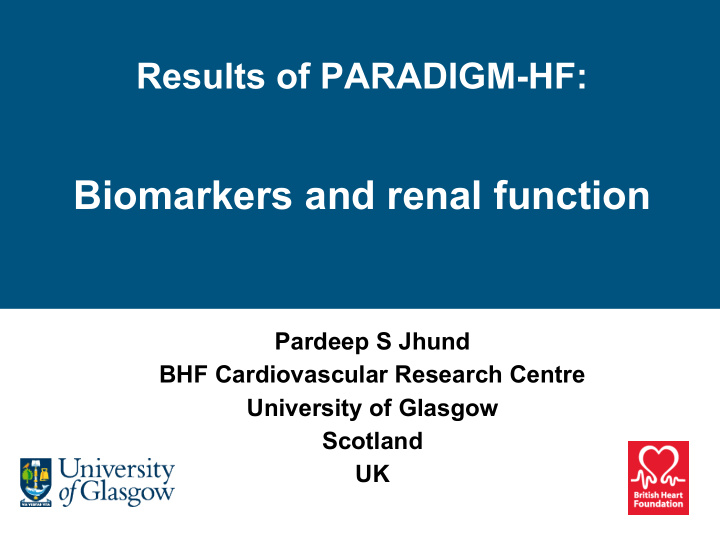



Results of PARADIGM-HF: Biomarkers and renal function Pardeep S Jhund BHF Cardiovascular Research Centre University of Glasgow Scotland UK
Declaration of interest Consulting: Novartis
Overview · Biomarkers – natriuretic peptides – aldosterone – hsTnT – galectin-3 · Renal – cystatin C – Renal outcomes – Renal safety
Angiotensin Receptor Neprilysin Inhibition (ARNI): LCZ696 LCZ696 valsartan sacubitril Natriuretic peptides Angiotensin II BK, ADM Subs-P, VIP, CGRP • Vasodilation AT 1 Receptor Neprilysin • Natriuresis • Vasoconstriction • Diuresis • Sodium/water retention • Inhibition of pathologic Degradation • growth/fibrosis Fibrosis/hypertrophy products
Angiotensin Receptor Neprilysin Inhibition (ARNI): LCZ696 LCZ696 valsartan sacubitril Natriuretic peptides Angiotensin II BK, ADM Subs-P, VIP, CGRP • Vasodilation AT 1 Receptor Neprilysin • Natriuresis • Vasoconstriction • Diuresis • Sodium/water retention • Inhibition of pathologic Degradation • growth/fibrosis Fibrosis/hypertrophy products
NT pro BNP and BNP Cardiomyocyte Blood
PARADIGM-HF: NT-proBNP and BNP 500 LCZ696 1400 Enalapril 450 1300 1200 400 1100 NT-proBNP 350 1000 NT-proBNP pg/ml 900 300 BNP pg/ml 800 250 700 600 200 BNP 500 150 400 300 100 200 50 100 0 0 0 2 4 6 8 Months
Explaining the NT pro BNP and BNP changes with LCZ696 (schematic) Pro BNP/ BNP NT proBNP Inhibition of BNP breakdown Reduced LV wall stress Pre- Post- Pre- Post- LCZ696 LCZ696
PARADIGM-HF: Geometric mean urinary Geometric mean urinary PARADIGM-HF: cyclic GMP concentration by visit by visit cyclic GMP concentration Cyclic GMP is the intracellular second messenger stimulated by natriuretic peptides and other vasoactive substances including nitric oxide
Angiotensin Receptor Neprilysin Inhibition (ARNI): LCZ696 LCZ696 valsartan sacubitril Natriuretic peptides Angiotensin II BK, ADM Subs-P, VIP, CGRP • Vasodilation AT 1 Receptor Neprilysin • Natriuresis • Vasoconstriction • Diuresis • Sodium/water retention • Inhibition of pathologic Degradation • growth/fibrosis Fibrosis/hypertrophy products
Aldosterone 6 month mortality (%) 80 P<0.001 60 40 Val-HeFT 20 Valsartan reduces aldosterone levels 0 Below Above median median Plasma aldosterone Circulation. 1990;82:1730-1736 CONSENSUS Raised plasma aldosterone is associated with higher mortality Circulation. 2003;108:1306-1309
PARADIGM-HF: Aldosterone 2-4 wk enalapril then 3 –6 wk LCZ696 both arms 300 280 Plasma aldosetrone (pmol/L) 260 240 220 200 * * 180 160 LCZ696 140 * p<0.05 Enalapril 120 100 Prior to 1 month 8 months Randomization Run-in
Troponin and prognosis in HFREF Val-HeFT HR per 0.05ng/mL increase 1.20 (95% CI 1.10-1.30) 0.5 Cumulative mortality 0.4 Q4 0.3 Q3 0.2 Q2 0.1 Q1 0 18 24 6 12 Months Circulation. 2007;116:1242-1249
PARADIGM-HF: median hs-TnT (µg/l) concentration by visit Randomization Prior to Random- 4 weeks 8 months Run-in ization
PARADIGM-HF: hs-TnT (µg/l) by visit hs-TnT: % of patients >99 th centile (>0.014 µg/l) Treatment Baseline Random- 4 8 (prior to run ization weeks months -in)* Enalapril 58.2% 52.9% 58.0% 56.9% LCZ696 56.0% 50.8% 48.4% 48.1% LOD = 0.005 µg/l (5 pg/ml) LOQ = 0.013 µg/l (13 pg/ml) 99 th centile = 0.0142 µg/l (14.2 pg/ml) *3.9% had values <LOD at baseline
PARADIGM-HF: Galectin-3 by visit 2-4 wk enalapril then 3 –6 wk LCZ696 both arms 20 18 16 14 ng/ml 12 10 8 LCZ696 6 Enalapril 4 2 0 Prior to Randomization 1 month 8 months Run-in
Renal biomarkers and outcomes
Cystatin C · Cysteine protease inhibitor · Less influenced by age, sex, or race · Low molecular weight · Freely filtered and neither secreted nor reabsorbed · Sensitive measure of glomerular filtration · Higher levels associated with poorer prognosis Circulation: Heart Failure. 2012; 5: 602-609
PARADIGM-HF: Cystatin C 2-4 wk enalapril then 3 1.22 –6 wk LCZ696 both arms 1.2 1.18 1.16 mg/L 1.14 1.12 LCZ696 Enalapril 1.1 1.08 1.06 Prior to Randomization 1 month 8 months Run-in
Renal Outcomes
Renal progression: Protocol-defined endpoint Hazard LCZ696 Enalapril Ratio P- value Endpoint n/N (%) n/N (%) (95% CI) 1-sided Composite 94/4187 108/4212 0.86 0.1424 (2.2) (2.6) (0.65, 1.13) (i) 50% decline in 32/4187 42/4212 0.75 0.1118 eGFR (0.8) (1.0) (0.47, 1.19) (ii) >30 77/4187 69/4212 1.11 0.7283 ml/min/1.73m 2 (1.8) (1.6) (0.80, 1.53) decline in eGFR to <60 ml/min/1.73m 2 (iii) Reaching 8/4187 16/4212 0.50 0.0529 ESRD (0.2) (0.4) (0.21, 1.16)
Renal progression: Conventional renal endpoint (post-hoc analysis) Post-hoc analysis – based on conventional endpoint for renal disease progression (50% decline in eGFR or reaching ESRD) Endpoint LCZ696 Enalapril Hazard Ratio P Value n/N (%) n/N (%) (95% CI) 2-sided Composite 37/4187 58/4212 0.63 0.0276 (0.9) (1.4) (0.42, 0.95) (i) 50% decline 32/4187 42/4212 0.75 0.2236 in eGFR (0.8) (1.0) (0.47, 1.19) (iii) Reaching 8/4187 16/4212 0.50 0.1057 ESRD (0.2) (0.4) (0.21, 1.16)
Safety “With regard to healing the sick, ……… I will take care that they suffer no hurt or damage” Hippocratic Oath
PARADIGM-HF: Adverse events leading to permanent study drug discontinuation (%) Enalapril LCZ696 14 516 12 449 10 8 6 4 2 59 36 29 29 15 11 29 0 Any adverse Hypotension Renal reasons Hyperkalaemia event p = 0.03 p = 0.38 p = 0.002 p = 0.56
PARADIGM-HF: Renal safety Enalapril LCZ696 (%) P=0.15 20 18 16 15 10 P=0.007 P=0.10 P=0.007 6 5 4 5 3 2 1.5 0 Cr ≥ 2.5 Cr ≥ 3.0 K+ > 5.5 K+ > 6.0 mg/dl mg/dl mmol/l mmol/l (221 µmol/L) (265 µmol/L)
PARADIGM-HF: Renal safety by age P for interaction >0.05 for all events <55 years 55-64 years 65-74 years ≥75 years
Summary Treatment with LCZ696 led to: · Lower NT-proBNP and higher BNP levels · Lower troponin · No change in galectin-3 and cystatin C · No difference in rates of the composite renal outcome though reduction in 50% decline eGFR/ESRD · Less renal adverse events, even in the elderly
Thank you
Recommend
More recommend